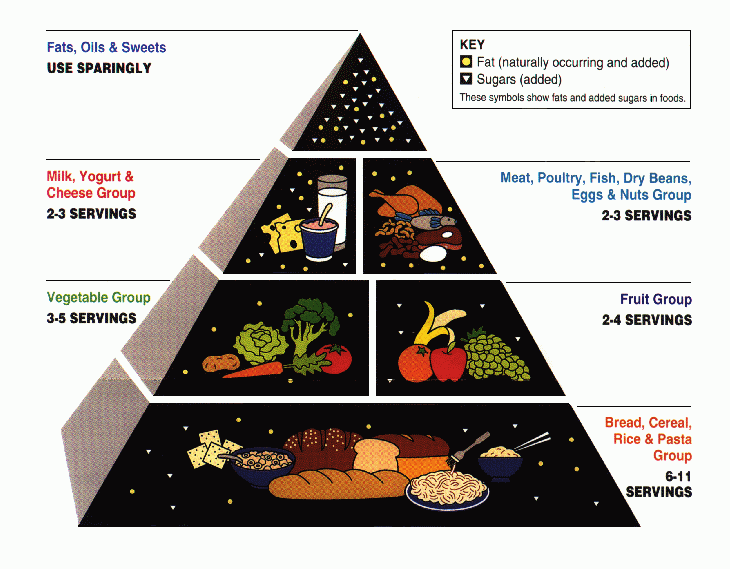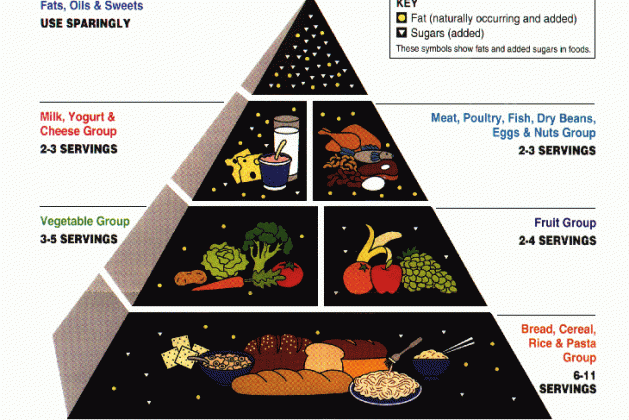
Making the decision to eat healthy and nutritious foods provides an opportunity for individuals to take control of their health. Eating right is only half of the equation – the other half is to exercise. Prior to the original food pyramid, individuals followed the RDA (or recommended daily allowances) concept, that was introduced in 1989.
It was not until 1992 that the USDA or the United States Department of Agriculture created the original food pyramid. The triangle-shaped pyramid contains all the recommended daily allowance of foods, fruits, vegetables and meats. The pyramid is a guide to helping individuals develop healthy eating habits.
Individuals can create nutritious meals based on the chart’s number of recommended daily servings from each food group. A more updated version of the pyramid was released in 2010.
Food Pyramid Basics
It is never too late to start eating healthy. People who change their lifestyle and eat healthy decrease their risk of heart disease, high blood pressure, stroke and diabetes. At one glance of the pyramid, individuals can plan their meals proportionally.
Adults should have at least a 2,000 calorie intake. The foods should consist of the items found on the USDA food pyramid. Here is a list of foods groups beginners should become familiar with:
-
Fruits (2-4 cups per day)
-
Vegetables (3-5 cups per day)
-
Dairy products (2-3 cups of milk per day)
-
Proteins (5 ½ ounces of lean meats including beans per day)
-
Oil (27 grams of non trans fats or oils per day)
-
Carbohydrates (6 ounces of bread, pasta and other carbohydrates per day)
Food Pyramid History
Through each stage of the pyramid over the last 97 years, the daily recommended allowances improved. There were obviously some important nutritional information missing in the past.
1916 – 1930: How to select foods for young children:
-
Constructed guide based on food groups and household size
-
Protective foods
1940: Basic seven:
-
Lacked serving size recommendation
-
Complicated guide
-
Included the basic seven foods from each group
-
Foundation for daily nutrition
1956 – 1970s: Food for fitness (Basic Four Foods)
-
Did not include the appropriate sections for sugars, fats and calories
-
Specified portions from the four food groups
-
Dietary approach
1979: Simple-to-understand daily food guide
-
Designed after the 1977 dietary guide was released
-
A fifth group was added to the pyramid to include the limited intake of fats, sweets and alcohol
1984: Food Wheel was introduced:
-
Daily food allowances
1992 – Present:
-
1992: Food guide pyramid
-
2005: My Pyramid Food guide system
-
2011: My Plate
How to Use the Food Pyramid
Beginners should base their meals on the foods listed in the food pyramid. These foods should be the bulk of their diet, and should be eaten in moderation. Eating several small meals throughout the day helps with indigestion and offers greater nutritional value than eating 3 large meals.
Understanding food labels and how they work can help maintain and regulate weight. Overeating is a common problem. Eating too much of some foods, no matter how nutritious they are, can lead to obesity and illnesses.
Discretionary calories are relatively new to the pyramid family. After individuals have consumed the recommended daily allowances, they can include other foods in the diets in moderation. This includes such foods as sweets, fats, and alcohol. These foods should be consumed in very small portions, with calorie intake up to 300. This is actually 8-20% of the total calorie intake allowance.
When the My Pyramid guide is followed properly, individuals will see a decrease or reduction in obesity. The key to staying healthy or getting off to a healthy start is to eliminate, or at least limit, fats and sugars. Most individuals do not include enough dark leafy vegetables, whole grains, low-fat dairy foods and legumes, such as beans and fibers, in their diets.
People who are having a difficult time getting started creating a pattern for healthy eating can create a unique menu using the “Seasons” menu. The seasons consist of eating rainbow foods. Children love eating with colors or rainbows – and the food pyramid contains pictures of colorful, healthy and nutritious foods. Following is an example of “eating with the season” or “eating with the nutritious meal”.
Sample Menu
Breakfast:
-
One egg
-
One yellow banana
-
One grain bran muffin
-
One glass of orange juice
Lunch
-
One red or golden apple
-
Green broccoli
-
Fish
-
Yellow squash
-
White rice
-
One plain yogurt
-
One glass of water
This sample menu contains all the foods that are included in the food pyramid chart – fruits, vegetables, lean meat, carbohydrates, sweets and dairy products.
Beginners can get off to a great start with a healthy heart, low calories and a balanced diet when they follow the USDA food pyramid of recommended daily allowances.
Take action! Create a menu based on the food pyramid and post it in the comments as a commitment for following through.




Leave a comment
You must login or register to add a new comment.